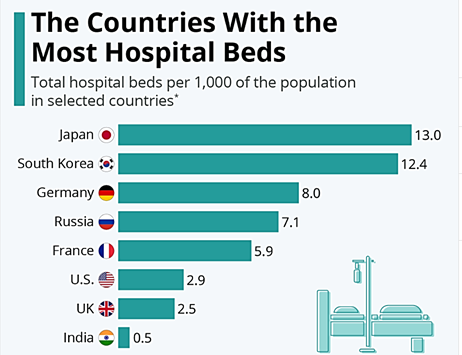IELTS Academic Writing Task 1 Sample 4
Hospital Beds
Following is a graph depicting top countries in terms of the number of hospital beds available to their citizens. Use the statistics to write about their potential capability to combat widespread diseases like COVID-19.
Additional Details:
Japan’s lead is also engineered by its policy of providing for geriatric care.
The number of hospital beds does not necessarily mean intensive care units.
Developed and underdeveloped nations differ in terms of their overall capability to provide standard healthcare facility to citizens.

-
Sample Answer |
|---|
The bar graph shows the list of the top eight countries in the world offering the highest number of hospital beds per 1000 citizens. Japan leads the tally with 13 beds per thousand people, followed by South Korea with 12.4. Germany is at the third position with 8 beds, succeeded closely by Russia with 7.1. This is followed by France, the USA, and the UK with 5.9, 2.9, and 2.5 beds, respectively. India occupies the bottom position with less than a single bed per 1000 citizens. The list has three countries each from Europe and Asia, one from North America, and one transcontinental country. Most of these are developed nations. Since the number of hospital beds per thousand people is not an indication of available intensive care units, one cannot infer that countries occupying the lead positions here are better than the remaining in terms of their capability to combat widespread epidemics such as the COVID-19 pandemic. Japan makes a better provision for hospital beds under a national policy to support geriatric care. Also, there is a significant difference between developed and underdeveloped countries with respect to the universal quality of healthcare infrastructure, which impacts the effectiveness of their emergency measures when fighting epidemics. |
-
Analysis |
|---|
COHERENCE AND COHESION
|
GRAMMAR
|
LEXICAL RESOURCE leads the tally - a strong way of saying that someone or something is at the top or leads by numbers/scoring respectively - a great word to use when commenting on lists of information. It helps to link two sets of interconnected data. For example, “A, B, and C are like 1, 2, and 3, respectively.” transcontinental - a sophisticated composite word to describe a country spanning more than one continent infrastructure - the underlying or basic structures or systems of a country (in this context); e.g. transport, water, energy, healthcare, etc. |